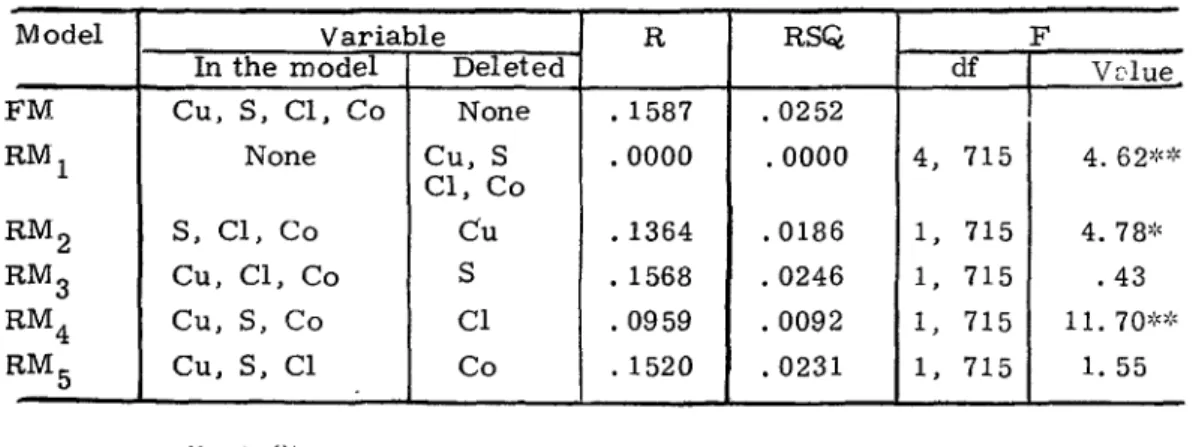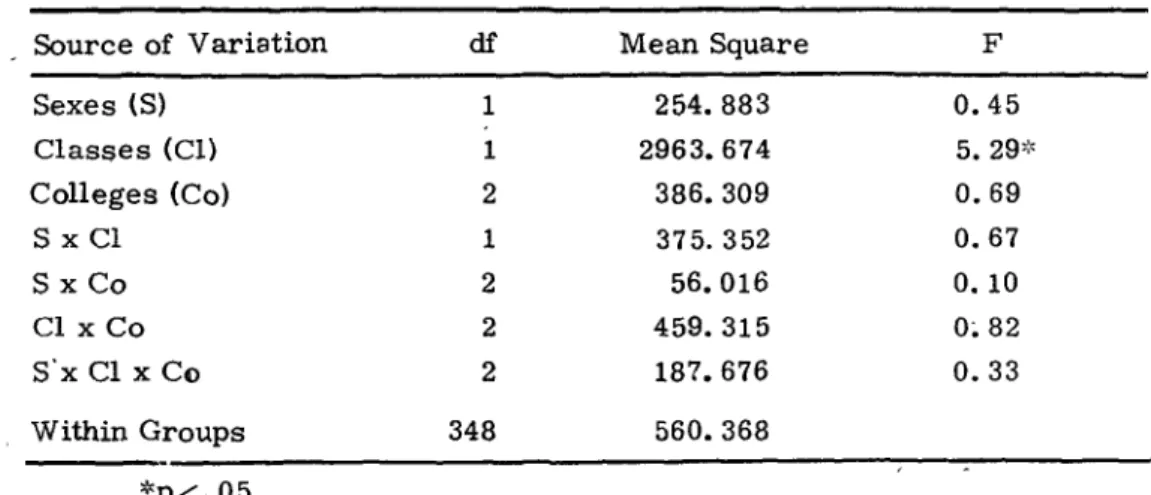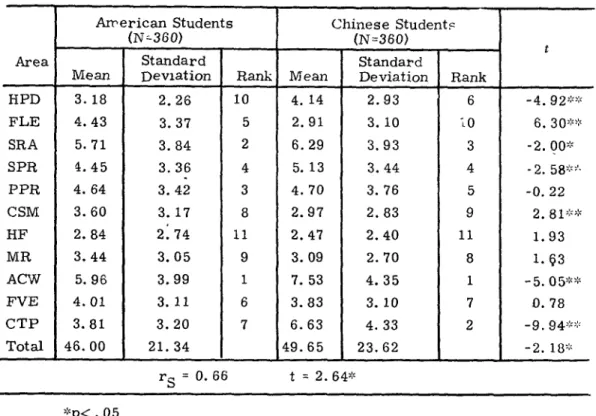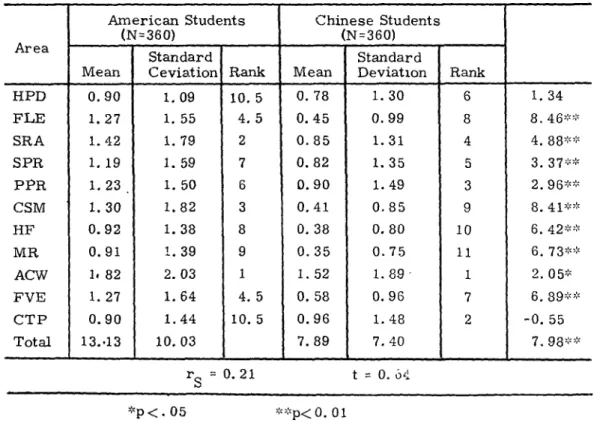ACom開 rative Study of Adjustment Problems Among Chinese andAmerican-College Students 77
A COMPARATIVE STUDY OF ADJUSTMENT PROBLEMS AMONG
CHINESE AND AMERICAN COLLEGE STUDENTS
MAW 可 FA
CHIEN
INTRODUCTION
College students, in a transitional period from late adolescence to early adulthood, meet many new and ever-complicated environments which they have neverencountered before. They experience a wide variety of difficulties in making satisfactory adjustments to col!ege life. Personality problems are frequently precipitated in college students by stresses met in attempted adjust-ments to perplexing situations. Therefore, college faculty 訟ld guidance personnel should be aware of the conCerns and problems of the students whorr.
they serve. If the information about adjustment problems of college students is available and their needs and feelings are considered 臼ld understood,位le
professional staff in college will be in a better position to provide adequate edu-cation for students.
During the last three decades increasing attention has been given to per-sonality development and adjustment problems of college students. A growing number of studies have been directed toward exploringvarious aspects of college students ' problems. From a review of the related literature
,
it is evident that investigators have used various techniques in an effort to better understand the concerns and problems of college students. The methods most frequently used are the questionnaire and checklists. Most ofthe studies were general in nature,directed toward discovering what kinds of problems college students were usually faced with. A few studies were concerned with the problems of special types and classes of students in colleges. It was indicated that college life became increasingly harassing and a variety of perplexities were encountered by college students. In general, problems in regard to effective ~tudy and adjustment to college work were most frequently perceived and reported by the subjects in various studies. However, many kinds of personal and social troubles were also frequently found to underlie academic problems. Factors related to the reported problems of college students were examined,位ld some researchers (Hartman; 1968; Hu, 1967; Ottoson, 1968; Suinn, 1967) found that student pro-blems were a function of sex and year in college. .
Itappeared tl1at few research projects had put much emphasis on the problem patterns of college students in different learhing environments, and that no comparisons had been made between the adjustment problems experienced by
78 教育心理學報
college students in two different countries. A comparative study of the college
student problems in the light of different cultural backgrounds, especblly
be-tween Western and Eastern societies,seem st泣I neglected. In order to provide
some data in this respect, the present study was undertaken.
The chief concern of this study was to ascertain
,
compare,
and analyze theself-perceived and self-reported problems of Chinese 臼1d Am eric缸1 undergra~
duate students. To achieve this major purpose, the following aspects of the
problem were explored:
1. To identify the distinctive personal problems of Chinese and American college students.
2. To analyze the patterns of problems of Chinese 位1d American college
students.
3. To compare the individual predominant problems 缸1d major problem
areas between Chinese 缸ld American college students.
4. To determine the relationship between the problems expressed and
variables such as cultural background, sex,class, and college of major.
5. To examine the cources of help which Chinese 缸ld Am eric紅1 college
students preferred to seek for their problems.
METHOD
Su~ects The sample for this study consisted of 360 Chinese undergraduate
students drawn, by stratified. sampling, from 址1e National Taiwan Normal
University and an equal number of American undergraduate students from the
University of Northern Colorado. Oiily those who were between 18 位1d 25 years
of age were selected as subjects. Both Chinese and American student groups
were further divided into subgroup訪19S on the basis of sex, class ,臼1d college
of majdr.
Ins truments The Mooney Problem Check List (College Form
,
1950 Revision)and a Chinese Revision of 也e Mooney Problem Check Llst (College Form) were
used as an instrument to gather data concerning 血e individual problems and
R、oblem areas of American and Chinese college students. Recognizing the
limitations of 血e MPCL 前1d 詛 orderto examine the sources of help sought by
college students
,
the. writer prepared an one-page supplementary questionnaire{詛 Chinese 缸ld in t;nglish) which consisted of two parts. The first part was a question which asked the student to l'ist the personal problem of most concern
缸1dthree other perceived problems.The second part Was a checklist of persons
i 、
with whom the student would like to discuss his own problems and from whom he would seek help.
AComparative Study of Adjustment ProblemsAmo~ Chinese and Am eri 個nCollege Students 79
students 扭曲 is study were obtained through the administration of theMPCL 紅ld a supplementary questionnaire devised bythe writer. The testing was conducted under the supervision of the writer andan assistant in a regular class setting during 也e fall quarter or the first semester of the 1972-1973 academic year.
Before administration of the MPCL, the supplementary questionnaire was
distributed to each subject
,
who 缸lswered it 旭 the first five minutes. l'.fter-war缸,也e subjects took the MPCL, following 也e directions as stated onthe
first page of the booklet. No time limits were used. Inan effort to assure
confidentiality and to encourage the subjects to respond openly. anonymity was maintained by allowing the students to write their code numbers instead of their names on the answer sheets.
Methods of Data AnalysisThe MPCL answer sheets of the subjects were
carefullyhand-tabulatedby the writer in' an effort to keep errors to a minimum.
甘le raw scores and related information obtained from 役時 individualsubjects
were entered onmaster sheets,from whichmM cards were 夙mched. Statistical
analyses of data were performed by the computer mM-360 atthe Computer
Center of the University of Northern Colorado. Procedures for the analysis of
data were as follows:
1. The raw data were analyzed by employing 位le multiple linear regression
technique to determine the relationship between the criterion and predic-tors.
2. Frequency means 缸ld standard deviations of each problem area 缸ld of
the total on the MPCL for each student group were computed.
3. Analysis ofvariance 位ld the t test for multiple comparisons were utilized
todetermine也e signific自lceaf differences among or between the problem frequency means of various student groups.
4. Spearman's Rank Correlation Coefficients were calculatedto determine
the degree of agreement between 沿le rankings of problem areas for
various student groups,如d t was used to test the significance of
cor-relation coefficients obtained.
5.τ'he percentage of Chinese college students 臼ldAmerican college students
checking each individual problemon 位leMPCL was computed respectively.
6. The percentage of Chinese college students andAmerican college students
checking ecah source of help on the supplementary questionnaire was
computed respectively
,
and z was used to test the significance ofdifferences between two groups.
80 教育心理學報
RESULTS
1. The Multiple Regression An泊 lysis
Table 1 shows the values of wultiple correlation coefficient (R), RSQ, and F of one full model and five restricted models with the total problems of concern reported on 血e MPCL as th& criterion. Each or all of the four predictor vari-abIes including cultural background (Cu), sex (5), class (Cl), and college of major (Co),of the student were deleted in the restricted models as shown in the Table. The results pointed out that:
Table 1. Regression Analysis of the Contribution of Predictor Variables to the Prediction of the Total Problems of
Concern Reported on the MPCL
F RM
Model Variable 民 RSQ F
In the model Deleted df Vr,lue
Cu, S, CI, Co None .1587 .0252 1 None Cu, S .0000 .0000 4, 715 4. 62':":' CI, Co 2 S, Cl, Co eu .1364 .0186 I, 715 4.78':' 3 Cu, CI, Co S .1568 .0246 1, 715 .43 4 Cu, S, Co Cl .0959 .0092 1, 715 11. 70':":' 5 Cu, S, CI Co .1520 .0231 I, 715 1.55 MM RRRR 平 p<.υb 牢牢 p< ﹒ 01
1. The full wodel (FM) which included all 4 predictor variables to predict the criterion yielded an R of .1587 位ld 自1 RSQ of . 0252 indicating that these predictor variables together accounted for 2.52 per cent of the total variance in the criterion. When this RSQ was tested against chance (RM
1),缸lF-value of 4.62 was obtained which was statistically significant at the. 01 level.
2. When the variable of culture was rleleted,I the RM"~OI._ ..."....'...2.., yielded an R of .1364
and an RSQ of .0186; it indicated that the cultural background of the students accounted for O. 66 per cerU. ( .0252 個 .0186
=
.0066)of thevariance in the criterion. When this RSQ was tested against the H.SQ 詛 the FM,an F-value of 4.78 was obtained which was statistically sigr泣,
ficant at the. 05 level.
3. When 甘le variable' of sex was deleted,也e RM3 yielded an R of .1568 and an RSQ of .0246; it indicated that the sex of the students accounted for only,0.06 per cent (.0252 - • 246=.006)of 沿海 variance in 甘le criterion.
A Comparative,Study of Adjustment ProblemsAmOng Chinese and American College Students 81 was obtained which was not significant.
4. When the variable of class was deleted. the RM4 yielded an R of .0959 and an RSQ of .0092; it indicated that the class of the students accounted for 1. 60 per cent (.0252 - .0092
=
.0160) of the variance in the criterion. IWhen this RSQ was tested against the R訊之 inthe FM. an F-value of 11.70 was obtained which was statistically significant at the . 01 level.
5. When the variable of college was.deleted. the RM5yielded an R of. 1520 and an RSQ of .0231; it indicated that the college of the students' major accounted for only O. 21 per cent (.0252 - .0231 = .0021) of the variance in the criterion. When this RSQ was tested against the RSQ in the FM. an F-value of 1.55 was obtained which was not significant.
2. The Analysis of Variance of Problems
Table 2 shows the analysis of variance of total problems which were of con-cern to the Chinese college students. The F-value for classes was the only one significant at the. 05 level. indicating that the differeJ;}ce between the frequency means of total problems reported on 血e MPCL for lowerclassmen and for upperclassmen.52.52缸ld 46.78 respectively. was statistically significant.
Table 2. Analysis of Variance of the Total Problems of Concern on the MPCL for the Chinese College Students
Source of Variation df Mean Square F
Sexes (S) 1 254.883 0.45 Classes (Cn 1 2963.674 5.29':' Colleges (Co) 2 386.309 0.69 S x Cl 1 375.352 0.67 S x Co 2 56.016 0.10 Cl x Co 2 459.315 。~82 S'x Cl x Co 2 187.676 0.33 Within Groups 348 560.368 *p<.05
Table 3 reveals the analysis of variance of total problems which were of concern to theAmerican college students. C沈lly the' F-value for classes was sign江icant at the .05 level. The frequency means of total problems reported on 也e MPC~ for lowerclassmen and for upperclassmen. 48. 83 arid 43. 17 respectively. were significantly different.
報
位IeTotal Problem s of Concern on the
學
Analy sis of Variance of
MPCL for the American College Students
理 心 育 教 Table 3. 82 F 3.01 6.47* 2.69 0.44 0.87 0.92 0.14 Mean Square 1345.079 2888.791 1199.239 195.583 387.303 410.977 64.044 df 可iτ4n4 ,An4ndn4 Source of Variation 富xes (罰 Classes (el) Colleges (Co) S x CI S x Co CI x Co S x CI x Co 446.487 ;;'p<.05
3.
Comparison of Frequency Means and Rank Orders of Problem348 Within Groups
Areas
Tables 4 and 5 present comparisons between the whole group of American
and the whole group of Chinese college students.
while Table 5 deals with the problems of
Table 4
college
deals with the problems of concern,
students 口lOstconcern.
Table 4 indicates that Chinese students reported more problems of concern
in the total and in the areas of HPD. SRA. SPR. ACW. and CTP, but fewer
problems in the areas of FLE and CSl'頃, than American students. There were
no significani differences between 扭扭 two groups in the areas of PPR,HF, MR,
and FVE. Major problem areas of concern were ACW, SRA. PPR. SPR. and
Fl E for American students; ACW. CTP. SRA. SPR. an!i PPR for Chinese
In general. there was significant agreement between the rankings of
problem areas by American 訟ldChinese students.
Table 5 shows that American students reported more problems ofmost
concern in the total and in all areas except HPD and CTP 出an Chinese students.
Major problem areas of most concern were ACW, SRA, CSM, FLE, and FVE
for American students; ACWI CTP. PPR. SRA,紅ld SPR for Chinese Students.
The rankings of problem areas by American and Chinese students were not
congruent.
4.
Comparison of Predominant Problemsstudents.
There were 74 problems on theMPCL checked as of concern by20月70or more
of American college students and 75 by Chinese college students.
predorr:in目前 problems. 30 were checked by both groups. Itwas found American students had more predominant problems than Chinese students
訂閱 areas of FLE. SRA, CSM. HF. MR, and FVE, whereas Chinese students
had more predominant problems than American students in the areas of HPD
,
ACW, and CTP. They had an equal number of predominant problems in
ζ)f these
that In
SPR,
AComparative Study of Adjustment Problems Among Chinese and Amencan College Students 83
Table 4. Comparison of Frequency Means of Proble汀;s of Concern and
Rank Orders of Problem Areas between the Whole Group
of Am e~icanCollege Students and the Whole Group of Chinese College Students
Arr>erican Students Chinese Student>,
(N=-360) (N'=360)
t
Area Standard Standard
Mean Devlation Rank Mean Deviation Rank
HPD 3. 18 2.26 10 4. 14 2.93 6 -4.92 牢牢 FLE 4.43 3.37 5 2.91 3. 10 -LO 6.30 非非 SRA 5.71 3.84 2 6.29 3.93 3 -2.00':' SPR q,.45 3.36
.
4 5. 13 3.44 4 -2.58':廿九 PPR 4.64 3.42 3 4.70 3. 76 5 -0.22 CSM 3.60 3.17 8 2.97 2.83 9 2. 81':"~ HF 2.84 2.74 11 2.47 2.40 11 1.93 MR 3.44 3.05 9 3.09 2.70 8 1.93 ACW 5.96 3.99 1 7.53 4.35 1 -5.05中* FVE 4.01 3.11 6 3.83 3.10 7 。 .78 CTP 3.81 3.20 7 6.63 4.33 2 -9.94扣;ζ Total 46.00 21.34 49.65 23.62 -2.18':' ':'p<.05 *~'p< ﹒ 01 rs
'= 0.66 t =2.64':'There were 22 problerr.s on the NfFCL checked as of rrost cqncern by 10lfo
or more of American college students 臼ld 12 by Chinese college students. It
was found that American students had predominant problems of most concern in
all areas except MR, while Chinese students had no predominant problems of
most concern in the areas ofFLE, CS恥, HF ,缸ldMR. Half of Chinese students1
predorrinant problems of most concern were in two areas of ACW and CTP.
5.
ComDarison of the Preferred Sources of HelpThe results presented by Table 6 were based on the analysis of the students'
responses to the second part of the sup抖ementa.ryquestionnaire. The
percen-tages of American and Chinese college students checking each source of ~elp
were compareo
,
and z value was obtained for each comparison. Table 6 indicates84 教育心理學報
Table 5. Comparison of Frequency Means of Problems of Most Concern and Rank Orders of Problem Areas between the Whole Group of
American College Students and the Whole Group of Chinese College Students
American Students Chinese Students
(N=360) (N=360)
Area
Standard Standard
Mean Ceviation Rank Mean DeviatIon Rank
HPD 0.90 1.09 10. 5 0.78 1.30 6 1.34 FLE 1.27 1.55 4.5 0.45 0.99 8 8.46 牢牢 SRA 1.42 1. 79 2 0.85 1.31 4 4.88':乞中 SPR 1.19 1.59 7 0.82 1.35 5 3.37':"~ PPR 1. 23 L 50 6 0.90 1.49 3 2.96 扣:ε CSM 1.30 1.82 3 0.41 0.85 9 8. 41 ':":' HF 0.92 1.38 8 0.38 0.80 10 6.42牢牢 MR 0.91 1.39 9 0.35 0.75 11 6. 73':":' ACW 1. 82 2.03 1 1.52 1.89- 1 2.05';' FVE 1. 27 L 64 4.5 O. 58 0.96 7 6.89 牢牢 CTP 0.90 1.44 10.5 0.96 1.48 2 -0. 55 Total 13.-13 10.03 7.89 7.40 7. 98':":' r
s
=0.21 t=0.0"l ;'<p<.05 串串p<0.01Table 6. Corr、 parisonof Preferred Sources of Help between American College Students and Chinese College Students
Source of Help
Parent
Relative, not parent Faculty adviser Professor, not student ' s adviser Counselor E江inister Doctor Friend Other No one ~'p<.05 ~'*p<﹒ 01 Per Cent of American Students Checking Source 25.28 9.44 5.56 6.11 31.39 10.28 7.22 51.67 15.56 13.61 Per Cent of Chinese Students Checking Source 42. 50 16.11 21.39 18.89 8.06 6.11 4.44 45.28 1.94 11.66 Z -4.88':'* -2.68':口::: -6. 22':":' -5.18':吽 7.87 牢牢 2.04 申 1.59 1.72 6.46半* 0.79
A 臼mparativeShldy of Adjustment Problems Among Chinese andAmerican College Students 85
1. Approximately half of American college students 臼ld Chinese college
students preferred to talk over their problems with friends. There was
no significant difference between the two groups.
2. Chinese college students were more willing than American college students
to seek help from their parents
,
relatives,
faculty advisers,
and otherprofessors.
3. American college students were more willing than Chinese college students
to consult counselors
,
m缸listers , and other personnel not included on thelist.
These differences might be due to different value systems
,
cultural settings,
and provisions of counseling service.
SUMMARY
This study has been oriented toward an investigation of college students'
adjustment problems in the light ofdifferent cultural backgrounds
,
with thevariables of sex
,
class,
and college ofmajor being taken into consideration. Thepurposes of this study were.to identify,compare ,個danalyze the self-perceived
and self-reported problems of Chinese and American undergraduate students
,
and to examine the sources of help which theyrnightprefer to seek for dealing with'their own problems.
Seven hundred and twenty undergraduate students were drawn
,
by stratifiedsampling
,
from the National Taiwan Normal University and the University ofNorthern Colorado. The Mooney Problem Check List (College Form) 位ld a
supplementary -questionnaire devised by 也e writer were administered to the
subjects 詛 regularclass settings.
The major findings based on 也e statistical analysisof datawere as follows:
1. The college students' cultural backgrounds were significan位y correlated
wi也 the number ofproblems reported on the MPCL.
2.For bothAmerican 缸ldChinese college /students
,
lowerclassmen reportedmore total problems of concern than did upperclassmen.
3. Chinese college students reported slightly more total problems of concern
than didAmerican college students;While 也e latter reported considerably
more total problems of most concern.
4. The major problem areas of Chinese college students were ..Adjustment
to College Work
,"
"Curriculum and Teaching Procedure,"
"Social andRecreational Activities
,"
"Social - Psychological- Relations,"缸ld "Per-sonal";'Paychological Relations."5舟,叮le major problem areas ofAmerican college students were"Adjustment to College Work." "Social and Recreationhl Activities
,"
Personal-Pay.86 教育心理學報
chologlcal Relations,II "Social-Psychological .H.elations,"缸ldIIFinances,
Living Conditions
,
and Employment. "6. Both Chinese and American college students preferred to talk over their problems with friends. In addition
,
Chinese students were inclined to seek help from parents,
relatives,
and professors; American students tended to consult counselors,
parents,
and ministersREFERENCES
. students.
(1) Berry, G. L. , and Tidwell, R. Student teacher problems and their coun· seling needs. Journal of the Student Personnel 4ssociation for Teltche
Edurat /l泊, 1972. 11. 49~60.
(2) Burgess. T. C. Review_of the Mooney Problem Check List. In O. K. Burol
(Ed.), The sIXth mental measurements yearbook. Highland Park, N. J.
Gryphon Press
,
1965,
318-319.(3) Feldman,K. 丸, and Newcomb,T. M. The impact of college on
:Vols. 1 and 2. S缸1 Francisco: Jossey-Bass
,
1969.(4) Hartman, B. J. Survey of college students' problems identified by thl Mooney Problem Chick List. Psychological Report, 1968, 22, 715-716. (5) 只u. P. C. The revision of the Mooney Problem Check List and its app1ica' !~o_n on the study ~f_ _c_oll~~e_~t~<!.~nt Problems. The National Chengchi
UniversIty Journa~ '967, 15, 55-166.
(6) Kelly, F. J. , et al. Research design In the behavioral sciences: . Multipb.
regressIOn approac 九 Carbondale & Edwardsville: Southern illinois Uni·
versity Press, 1969.
(7) Ottoson, J. W. A longitudinal study of the expressed problems of student: attending a midwestern church咀 related liberal arts college. Dissertatiol
Abstracts. 1968, 28(10-A). 4007-4008,
(8) Suinn
,
R. NL Types of student problems as a function of year in collegl for males and females. College and Universi紗, 1967. 42, 221-230. (9) Vittenson, L. K. AreaE; of concern to Negro college students as indicated byt_?~ir respo?!~.,:; t.?_th:~ ~~oney Problem Check List. .Journal of Negro
EducatlOll. 1967, 36, 51-57.
(10) Yarrow,W. H. Aninvestigation ofthe problems of entering freshmen at tne U~~ve~~~t:y of Southern lVllssisSlppi, Dissertation Abstracts, 1966, 26(8),
中美大學生適應問題之比較研究



